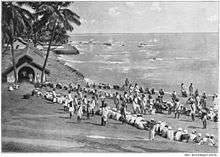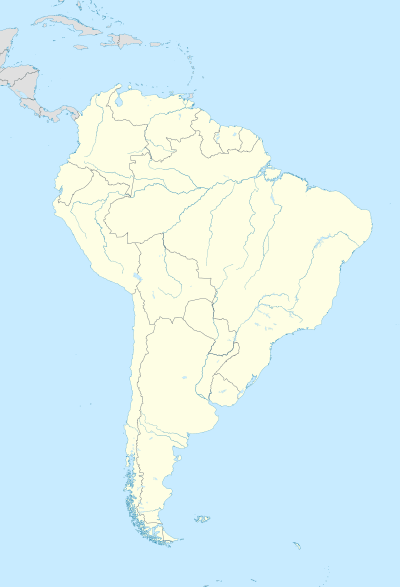Penal colony
A penal colony or exile colony is a settlement used to exile prisoners and separate them from the general population by placing them in a remote location, often an island or distant colonial territory. Although the term can be used to refer to a correctional facility located in a remote location it is more commonly used to refer to communities of prisoners overseen by wardens or governors having absolute authority.
Historically penal colonies have often been used for penal labour in an economically underdeveloped part of a state's (usually colonial) territories, and on a far larger scale than a prison farm.
British Empire

The British used colonial North America as a penal colony through a system of indentured servitude. Merchants would transport the convicts and auction them off (for example) to plantation owners upon arrival in the colonies. It is estimated that some 50,000 British convicts were sent to colonial America and the majority landed in the Chesapeake Colonies of Maryland and Virginia. Transported convicts represented perhaps one-quarter of all British emigrants during the 18th century.[1] The colony of Georgia, for example, was first founded by James Edward Oglethorpe who originally intended to use prisoners taken largely from debtors' prison, creating a "Debtor's Colony," where the prisoners could learn trades and work off their debts. Even though this largely failed, the idea that the state began as a penal colony has persisted, both in popular history and local lore.[2]
When that avenue closed in the 1780s after the American Revolution, Britain began using parts of what is now known as Australia as penal settlements. Australian penal colonies included Norfolk Island, Van Diemen's Land (Tasmania), Queensland and New South Wales. Advocates of Irish Home Rule or of Trade Unionism (the Tolpuddle Martyrs) sometimes received sentences of deportation to these Australian colonies. Without the allocation of the available convict labour to farmers, to pastoral squatters, and to government projects such as roadbuilding, colonisation of Australia may not have been possible, especially considering the considerable drain on non-convict labor caused by several goldrushes that took place in the second half of the 19th century after the flow of convicts had dwindled and (in 1868) ceased.
Bermuda, off the North American continent, was also used during the Victorian period. Convicts housed in hulks were used to build the Royal Naval Dockyard there, and during the Second Boer War (1899–1902), Boer prisoners-of-war were sent to the archipelago and imprisoned on one of the smaller islands.
In colonial India, the British made various penal colonies. Two of the most infamous ones are on the Andaman Islands and Hijli. In the early days of settlement, Singapore Island was the recipient of Indian convicts, who were tasked with clearing the jungles for settlement and early public works.
A common misconception is that most of the former British Empire colonies were formed via convicts sent over from Britain thus rendering countries like Australia a nation of convicts, where in reality they represented only a fraction of the established colonies at that time.
France
France sent criminals to tropical penal colonies including Louisiana in the early 18th century.[3] Devil's Island in French Guiana, 1852–1939, received forgers and other criminals. New Caledonia and its Isle of Pines in Melanesia (in the South Sea) received transported dissidents like the Communards, Kabyles rebels as well as convicted criminals between the 1860s and 1897.
The Americas

- Brazil had a prison on the island of Fernando de Noronha from 1938 to 1945.
- Gorgona Island in Colombia housed a state high-security prison from the 1950s. Convicts were dissuaded from escaping by the poisonous snakes in the interior of the island and by the sharks patrolling the 30 km to the mainland. The penal colony closed in 1984 and the last prisoners transferred to the mainland. As of 2015 most of the former jail buildings are covered by dense vegetation, but some remain visible.
- Once Spanish presence in Valdivia was reestablished in 1645 authorities had convicts from all-over the Viceroyalty of Peru construct the Valdivian Fort System.[4] The convicts, many of whom were Afro-Peruvians, became later soldier-settlers.[4] Close contacts with indigenous Mapuche meant many soldiers were bilingual in Spanish and Mapudungun.[5]
- During the 19th century Chile used Punta Arenas on the Strait of Magellan as a penal colony (1848–??).[6]
- Ecuador has used two islands in the Galapagos archipelago as penal colonies: the Island of San Cristóbal (1869–1904) and Isabela Island (1945–1959).
- Mexico uses the island of Isla María Madre (in the Marías Islands) as a penal colony. With a small population (fewer than 1,200), the colony is governed by a state official who is both the governor of the islands and chief judge. The military command is independent of the government and is exercised by an officer of the Mexican Navy. The other islands are uninhabited. Mexico announced on 18 February 2019 that it will close the Islas Marías Federal Prison, replacing it with a new cultural center.[7]
- In Paraguay the first ruler and supreme dictator Jose Gaspar Rodriguez de Francia opened the penal colony of Tevego in 1813, where mostly petty criminals were sent. It was abandoned in 1823, but re-established in 1843 as San Salvador. It was evacuated towards the end of the Paraguayan War of 1864–1870; soon afterwards Brazilian troops destroyed it.
- Argentina had a penal colony in Ushuaia, Tierra del Fuego, in the Patagonia region. It was active between 1902 and 1947.
Elsewhere
- The Qing Empire of 1644–1912 used Xinjiang Province in north-west China as a penal colony.
- Imperial Russia used Siberia and Russian Far East for penal colonies (Katorga) for criminals and dissidents. Though geographically contiguous with heartland Russia, Siberia provided both remoteness and a harsh climate. In 1857 a penal colony was established on the island of Sakhalin. The Soviet Gulag system and its tsarist predecessor, the katorga system, provided penal labor to develop forestry, logging, and mining industries, construction enterprises, as well as highways and railroads across Siberia and in other areas. In modern Russian Federation, corrective labor colonies are a common type of prison.
- The Kingdom of Hawaii under the rule of King Kamehameha III (reigned 1825–1854) replaced the death penalty with exile, and Kahoolawe became a men's penal colony sometime around 1830, while Kaena Point on Lanai served as the female penal colony. The law making the island a penal colony was repealed in 1853.
- Buru Island in Indonesia was used as penal colony during the New Order era to hold political prisoners.
- Apartheid South Africa used Robben Island as penal colony for anti apartheid activists.
- The Netherlands had a penal colony from the late 19th century. The Department of Justice took over the town of Veenhuizen (originally set up by a private company to "re-educate" vagrants from the large cities in the west like Amsterdam) to turn it into a collection of prison buildings. The town stands in the least populated province of Drenthe in the north of the country, isolated in the middle of a vast area of peat and marshland.
- Some sources refer to Third Reich forced-labor camps (Arbeitslager) in German-occupied Europe as penal colonies.[8]
- North Korea operates a penal system including prison labor camps and re-education camps.[9]
- Tarrafal operated as a Portuguese penal colony in the Cape Verde Islands, set up in 1936 by the head of the Portuguese government, Salazar, where anti-fascist opponents of this right-wing régime were sent. At least 32 anarchists, communists and other opponents of Salazar's regime died in this camp. The camp closed in 1954 but re-opened in the 1970s to jail African leaders fighting Portuguese colonialism.
- Spain maintained a penal colony on Fernando Po in present-day Equatorial Guinea.[10] The tiny island of Cabrera was also a short-lived penal colony in which approximately 7.000 French prisoners of war from the Battle of Bailén (1808) were left on their own for years; less than half of them survived.[11]
- Taiwan had a penal colony at Green Island during Chiang Kai Shek's White Terror of 1949–1987. As of 2015 the island is a tourist destination.
- Con Dao Island in Vietnam was used as a penal colony both by the French colonists (from 1861 onwards) and by the Republic of Vietnam (from 1954 and during the Vietnam War of 1955–1975).
- The Ottoman Empire used Fezzan as a penal colony, because it was the most remote province from then the capital city, Istanbul.
See also
References
Citations
- Ekirch, A. Roger (1987), Bound For America: The Transportation of British Convicts to the Colonies, 1718–1775, Oxford University Press.
- Butler, James Davie (October 1896), "British Convicts Shipped to American Colonies", American Historical Review 2, Smithsonian Institution, National Museum of Natural History
- Taylor, Alan. American Colonies. Penguin: London(2001).
- "Historia". Museo de Sitio Castillo de Niebla (in Spanish). Servicio Nacional del Patrimonio Cultural. Retrieved 7 April 2020.
- Urbina C., María Ximena (2017). "La expedición de John Narborough a Chile, 1670: Defensa de Valdivia, rumeros de indios, informaciones de los prisioneros y la creencia en la Ciudad de los Césares" [John Narborough expedition to Chile, 1670: Defense of Valdivia, indian rumours, information on prisoners, and the belief in the City of the Césares]. Magallania. 45 (2). doi:10.4067/S0718-22442017000200011. Retrieved 27 December 2019.
- "Colonización de Magallanes (1843-1943)". Memoria Chilena. Biblioteca Nacional de Chile. Retrieved 5 April 2020.
- [San Francisco Chronicle, 19 February 2019, p.A-2]
-
For example:
Feig, Konnilyn G. (1981). Hitler's Death Camps: The Sanity of Madness (reissue ed.). Holmes & Meier Publishers. p. 296. ISBN 9780841906761. Retrieved 29 June 2015.
[...] a forced-labor camp [...] named Arbeitslager Treblinka I [...] an order exists, dated November 15, 1941, establishing that penal colony.
-
Jager, Sheila Miyoshi (2013). Brothers at War: The Unending Conflict in Korea. Profile Books. p. 458. ISBN 9781847652027. Retrieved 29 June 2015.
Prison labor camps, or kwalliso, were first established in North Korea after liberation from Japan to imprison enemies of the revolution, landowners, collaborators, and religious leaders. After the war, these places housed un-repatriated South Korean prisoners of war. [...] There are six such camps in existence today, according to a May 2011 Amnesty International report, 'huge areas of land and located in vast wilderness sites in South Pyong'an, South Hamyong and North Hamyong Provinces.' ... Perhaps the most notorious penal colony is kwalliso no. 15. or Yodok [...].
-
Stewart, John (2006). African States and Rulers (3 ed.). McFarland & Company. p. 96. ISBN 9780786425624. Retrieved 29 June 2015.
From 1879 the Spanish basically used Fernando Po as a penal colony for captured Cuban rebels.
- Gates, David (1986). The Spanish Ulcer: A History of the Peninsular War. W W Norton & Co. ISBN 0-393-02281-1.
Sources
- Atkin, Malcolm (2004), Worcestershire under arms, Barnsley: Pen and Sword, ISBN 1-84415-072-0, OL 11908594MCS1 maint: ref=harv (link)
- Diiulio, John J., Governing Prisons: A Comparative Study of Correctional Management, Simon and Schuster, 1990. ISBN 0-02-907883-0.
- Dupont, Jerry, "The Common Law Abroad: Constitutional and Legal Legacy of the British Empire", Wm. S. Hein Publishing, 2001. ISBN 978-0-8377-3125-4.
- Johnsen, Thomas C., "Vita: Howard Belding Gill: Brief Life of a Prison Reformer: 1890–1989", Harvard Magazine, September–October 1999, p. 54.
- Serrill, M. S., "Norfolk – A Retrospective – New Debate Over a Famous Prison Experiment," Corrections Magazine, Volume 8, Issue 4 (August 1982), pp. 25–32.
- Mun Cheong Yong, V. V. Bhanoji Rao, "Singapore-India Relations: A Primer", Study Group on Singapore-India Relations, National University of Singapore Centre for Advanced Studies Contributor Mun Cheong Yong, V. V. Bhanoji Rao, Yong Mun Cheong, Published by NUS Press, 1995. ISBN 978-9971-69-195-0.